
Scudo d'argento (100 soldi), n. d., dies by Leone Leoni. Ø 43 mm, 33,73 g. CNI V p.231 n.15 tav.14/4; Crippa 4, Dav.8304. The Bavarian Coin Collection presents this piece in their permanent exhibition in Munich. Obv.: ·IMP·CAES·CAROLVS·V·AVG¤ - laureated bust, lion head at the shoulder. Rev.: ·TE·DEVM·LAV DAMVS· "We praise Thee, O Lord". Saint Augustine (kneeling) and Saint Ambrose (with crosier), flagellate between them and the Holy Spirit (pigeon) above. Exergue: the saints' names ·S·AVG·S·AMB·

Scudo d'argento da soldi 110, n. d. dies by Leone Leoni. Ø 43 mm, 36,90 g. CNI V p.232 n.17 tav.14/5; Crippa ?, Dav.8305. Specimen from Gabinetto Numismatico, Castello Sforzesco, Milan  . .
Obv.: as before. Rev.: ·DISCITE·IVS - ITI - IAM·MONITI et non temnere divos [Vergil, Aeneis 6,620] "Having been warned, study justice and learn not to despise the gods" Fight between Jupiter and the titans: above Jupiter sits on an eagle and hurls lightning, below defeated titans lay between rocks.
 "> ">
Mezzo Scudo d'argento, 1552. Ø 34 mm, 16,77 g. CNI V p.230 n.4; Crippa 6B. Obv.: ¤ IMP·CAES·CAROLVS·V·AVG· Rev.: ¤ CVIQ3ue - SVVM ¤ however, with the misprint GVIQ instead of CVIQ. "To each his own" - Crowned eagle above the globe with lightning and laurel in its claws. Globe between date I5 - 52.

Denaro da 32 soldi imperiali, n. d. Ø 34 mm, 10,85 g. CNI V p.233 n.26; Crippa 8C. Dies apparently not by Leone Leoni. Obv.: CAROLVS·V·IMPERATOR - laureated bust with the Golden Fleece on the breast. Rev.: SANTVS·AMBROSIVS· - Saint Ambrose with flagellate and crosier. Exergue: ·MLM· for Mediolanum "Milan". This coin was called burigozzo (from boricco, it. for hood) because of the appearance of the saints mitra.

Quarto di Scudo d'argento (Testone con la colonne), n. d. (1552). Ø 28 mm, 9.09 g. CNI V p.236 n.56; Crippa 11. Obv.: IMP·CAES·CAROLVS·V·AVG - laureated bust, annulet behind the neck. Rev.: the pillars of Hercules stand in the see and are embraced by a band with the motto "PLVS VLTRA". The reverse presents a so called 'impresa'.
A 'impresa' consists of a figure (body) and a motto (soul). The figure (pillars of Hercules) symbolize the Strait of Gibraltar. The motto ("always forward, even further") contradicted what people thought about the edge of the world. See more: coins from Charles V in Spain.

Prova in rame (pattern in copper). Cu Ø 28? mm, 9.11 g. CNI -; Crippa -; MIR -. Obv.: ·IMP·CΛES·CAROLVS·V·AVG Rev.: the pillars of Hercules stand in the see, band with the motto "PLVS VLTRA" as before.

Testone, dies by Jacopo da Trezzo. Ø 28 mm, 9,08 g. CNI V,236,57; Crippa 11A; Grechi 19. Obv.: IMP·CAES·CAROLVS·V·AVG - without inner circle. Rev.: In the waves of the ocean the Pillars of Hercules, entwined by a ribbon with the inscription PLVS VLTRA.

2 Scudi d'oro, n.d. Ø 27 mm, ca.6,6 g. CNI V p.231 n.14 tav.14/3; Friedb.708a. Obv.: ·IMP·CΛRS·CΛROLVS·V·ΛVG - Draped, laureate head of the Emperor to the right. Rev.: the pillars etc. as before, now with "imperial mitre" the crown suggesting a Bishops headdress.

Testone con la Salute (25 Soldi), n.d. (1552), dies by Leone Leoni. Ø 28 mm, 8,48 g. CNI V p.235 n.47; Crippa 12. Obv.: ·IMP·CΛES·CΛROLVS·V·ΛVG - laureated head. Rev.: SΛLVS ΛVG - VSTΛ The river deity Po lies propped up against an urn (river soarce); Salus, the Roman goddess of public well-being, feeds a serpent from a patera. Exergue: PADVS·MDL· PADVS = river Po ; MDL = MeDioLanum = Milan.

Testone con la Pace. Ø 30 mm, 9,82 g. CNI V p.234 n.41 tav.14/9 Obv.: IMP·CAEᔓ·CAROLVᔓ·V·AV - Laurel head right, as before. Rev.: CLAV - De - BELLI - PORTE "close the gate to war" The personification of peace stands in front of a building. Inside a chained person among weapons.

1/2 Testone (16 soldi), dies by Leone Leoni. Ø 28 mm, 5,34 g. CNI V p.237 n.63; Crippa 14. Obv.: ·IMP·CΛES·CΛROLVS·V·ΛVG - Laureate bust in cuirass. Rev.: OB / INSVB / RIΛM / SERVΛ / TΛM "ob insubriam servatam" = "saved because of Insubria" in oak wreath. Insubria was called the region around Milan.

Denaro da 10 soldi. Ø 27 mm, 3,28 g. CNI V p.238 n.74; Crippa 15. Obv.: IMP·CAES·CAROLVS·V·AVG - Laureate bust in cuirass to the right, double eagle below. Rev.: CHRIST·RELIG - PROPVGNATOR - Figure of Faith standing with cross and chalice between snake and board ( LVC / Q / R / LL) with a perforated handle on top.

Testone della pièta, n.d., dies by Leone Leoni. Ø 30 mm, 12,02 g. CNI V p.234 n.38; Crippa 26B. an outstanding Renaissance product in the best tradition of ancient Roman coins. Obv.: IMP·CAES· - CAROLVS·V·AVG - Charles V in classical armour and wearing a laurel crown. Rev.: ·Senatus·Populus·Que·MEDIOLanum·OPTIMO·PRINCIPI· "(dedicated) to the excellent prince by the senate and people of Milan", in correspondence with the antique SPQR (with R for Rome). PIETAS holds a Patera (for offering) and is seated between Roman armours on a throne with crossed legs; the motive follows the Sestertius of Caligula  (AD 37-41). (AD 37-41).
Exergue: PIETAS Further portraits on coins and medals by Leone Leoni Ref.:
|
| upgraded 10.2015. |
 start page
start page